Related Research Articles

Brittle stars, serpent stars, or ophiuroids are echinoderms in the class Ophiuroidea closely related to starfish. They crawl across the sea floor using their flexible arms for locomotion. The ophiuroids generally have five long, slender, whip-like arms which may reach up to 60 cm (24 in) in length on the largest specimens. From New Latin ophiurus, from Ancient Greek ὄφις + οὐρά.

Amphiuridae are a large family of brittle stars of the suborder Gnathophiurina. Some species are used to study echinoderm development and bioluminescence.
Ophiocanops fugiens is a living species in the brittle star family Ophiocanopidae. Though once considered to be the only one living species in this brittle star family, recent research has brought to light three specimens of Ophiocanops that differ substantially from O. fugiens. It has been regarded as the most primitive brittle star, close to Paleozoic forms, though other authors have disagreed with the view. Classification of O. fugiens is highly argued. Ophiocanops is usually placed in the order Oegophiurida or regarded as a genus incertae sedis or even given its own subclass Oegophiuridea. Some recent data suggest its relationship to the extant family Ophiomyxidae.

Ophiurina are a suborder of brittle stars containing the majority of living brittle star species.

Amphiura callida is a species of brittle star belonging to the family Amphiuridae. It is only known from the continental shelf off the coast of Cabo Frio, southeastern Brazil.
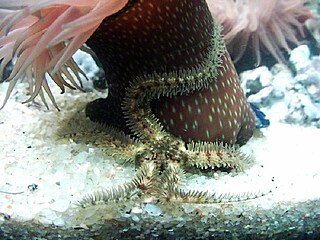
Ophiothrix fragilis is a species of brittle star in the order Ophiurida. It is found around the coasts of western Europe and is known in Britain as the common brittle star. It is also found along the coast of South Africa where it is known as the hairy brittle star.
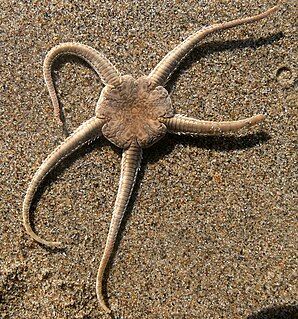
Ophiura ophiura or the serpent star is a species of brittle star in the order Ophiurida. It is typically found on coastal seabeds around northwestern Europe.
Ophiothrix suensoni, Suenson's brittle star or the sponge brittle star, is a species of marine invertebrate in the order Ophiurida. It is found in the Caribbean Sea and Gulf of Mexico. It is included in the subgenus Acanthophiothrix making its full scientific name Ophiothrix (Acanthophiothrix) suensoni.
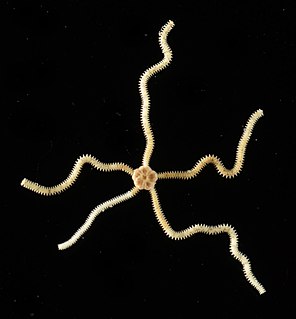
Amphiodia pulchella is a species of brittle star belonging to the family Amphiuridae. It is found in the Caribbean Sea and the Gulf of Mexico.

Ophionereis reticulata, the reticulated brittle star, is a brittle star in the family Ophionereididae. It is found in shallow parts of the western Atlantic, Caribbean Sea and Gulf of Mexico.
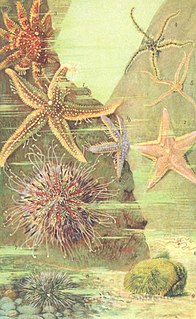
Amphiura filiformis is a species of brittle star belonging to the family Amphiuridae. It is found on the seabed in the north east Atlantic Ocean and adjoining seas to a depth of 200 metres (660 ft). It digs itself a shallow burrow in the sand and waves its arms in the water above to suspension feed on plankton.
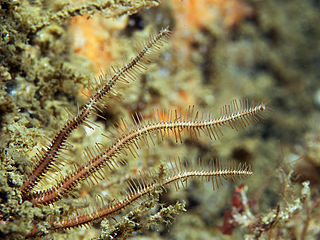
Ophiopsila aranea is a species of brittle star belonging to the family Ophiocomidae. It is the type species of the genus Ophiopsila

Amphipholis squamata, common names brooding snake star and dwarf brittle star, is a species complex of brittle stars in the family Amphiuridae.

Amphiura chiajei is a species of brittle star belonging to the family Amphiuridae. It is found in the northeastern Atlantic Ocean and adjoining seas to a depth of 1,000 metres (3,300 ft). It digs itself into the soft sediment of the seabed and raises its arms into the water above to suspension feed on plankton. It was first described by the British naturalist Edward Forbes in 1843, and was named for the Italian zoologist Stefano Delle Chiaje (1794–1860).

Ophiactis savignyi is a species of brittle star in the family Ophiactidae, commonly known as Savigny's brittle star or the little brittle star. It occurs in the tropical and subtropical parts of all the world's oceans and is thought to be the brittle star with the most widespread distribution. It was first described by the German zoologists Johannes Peter Müller and Franz Hermann Troschel in 1842. The specific name honours the French zoologist Marie Jules César Savigny.
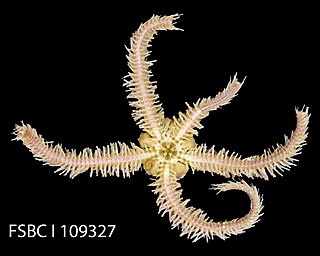
Ophiothrix angulata, the angular brittle star, is a species of marine invertebrate in the order Ophiurida. It is found in the warm waters of the western Atlantic Ocean, the Caribbean Sea and the Gulf of Mexico.
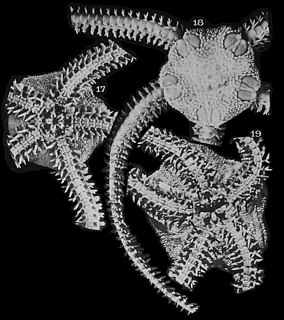
Acrocnida is a genus of brittle stars in the family Amphiuridae. The genus contains three members: Acrocnida brachiata, Acrocnida semisquamata, and Acrocnida spatulispina. There has also been observed hybridization between both Acrocnida brachiata and Acrocnida spatulispina. It is a fairly common genus, usually found along the coasts of Northwestern Europe, but with some species like semisquamata appearing around West Africa. Members of this genus primarily prefer intertidal and sub-tidal habitats, and they are they are less likely to be found in intertidal areas by comparison. This genus was not officially classified until 1926, by T. Gislén. One study found that due to the increased calcification that Acrocnida brachiata causes could be a potential source of Carbon Dioxide for not only the warm, shallow environments they live in, but also for the atmosphere.
Acrocnida brachiata, the sand burrowing brittlestar, is a species of brittle star in the family Amphiuridae. It occurs on the seabed in the northeastern Atlantic Ocean and the North Sea, living semi-buried in the sand with only its arm tips projecting.
Amphiodia urtica, commonly known as the burrowing brittle star or the long arm brittle star, is a species of brittle star belonging to the family Amphiuridae. It is found on the Pacific coast of North America at depths down to about 370 m (1,200 ft).
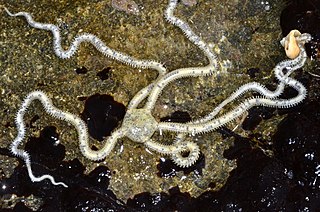
Amphiodia occidentalis or long-armed brittle star is a species of brittle star belonging to the family Amphiuridae. It is found in the Eastern Pacific coast from Alaska to USA.
References
- Maria da Natividade ALBUQUERQUE, Lúcia S. CAMPOS-CREASEY & Alain GUILLE (2001). "Two new species of Amphiuridae (Echinodermata, Ophiuroidea) from the southeastern coast of Brazil" (PDF). Zoosystema . 23 (3): 591–604.